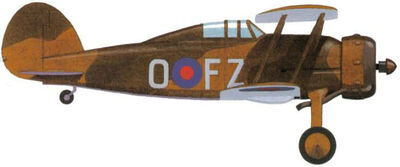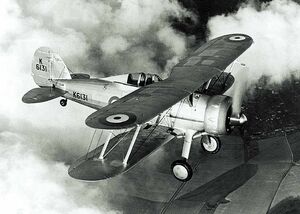The Gloster Gladiator (also known as the Gloster SS.37) is a 1930s British biplane fighter. The Gladiator entered service with the Royal Air Force in 1937 and was used in front-line fighter duties until around 1941, after being declared obsolete RAF Gladiators did non-combat work like meteorological work, Finland still used the Gladiator in combat duties until 1945. Portugal didn't retire the Gladiator until 1953.
The Gladiator was operated by: UK, Australia, Belgium, China, Egypt, Finland, Free France, Germany, Greece, Iraq, Ireland, Latvia, Lithuania, Norway, Portugal, Romania, South Africa, Sweden and the USSR.
Development
The Gladiator - a development of the Gloster Gauntlet fighter - was originally a private venture of by H.P Folland's team to meet Air Mininstry Specification F.7/30, which demanded a top speed of at least 250 mph and four machine guns, and encouraged the use of the new Rolls-Royce Goshawk engine.
Most of the Gladiator's opponent aircraft used the Goshawk engine, which proved to be unreliable, and Folland realised the Gauntlet could be quickly revised to meet the specification. The new SS.37 had reduced drag, because the SS.37 used single-bay wings instead of the double-bay wings used on the Gauntlet, and was fitted with a cantilever main undercarriage with internally sprung wheels.
The SS.37 first flew on 12th September 1934, initially powered by a 530 hp Bristol Mercury VIS engine, but was soon fitted with a more powerful engine, which meant the fighter reached 242 mph whilst carrying the four required machine guns.
On the 3rd April 1935 the RAF began operational evaluations on the SS.37, whilst Gloster planned a further improved model which had an 830 hp Bristol Mercury IX engine and a fully-enclosed cockpit, the Gladiator which entered widespread service had a top speed of 257 mph, and a fully-enclosed cockpit, the first fighter to have a fully-enclosed cockpit.
3 months later the RAF placed their first order of 23 to Specification F.14/35, and the aircraft was named the "Gloster Gladiator". This was followed by an order for 180 in September.
The Gladiator Mk I was delivered to the RAF from July 1936, and became operational in January 1937, this was soon followed by the improved Mk II, which had a slightly more powerful engine, and had a three-bladed metal propeller rather than two-bladed wooden one.
A modified Mk II called the "Sea Gladiator" was developed for the Royal Navy's Fleet Air Arm. The Sea Gladiator had an arrestor hook for landing on carriers, catapult points, a strengthened frame and an under-belly fairing for a dinghy lifeboat. Of the 98 Sea Gladiators built, or converted to, 54 were still in service when WW2 broke out in September 1939.

